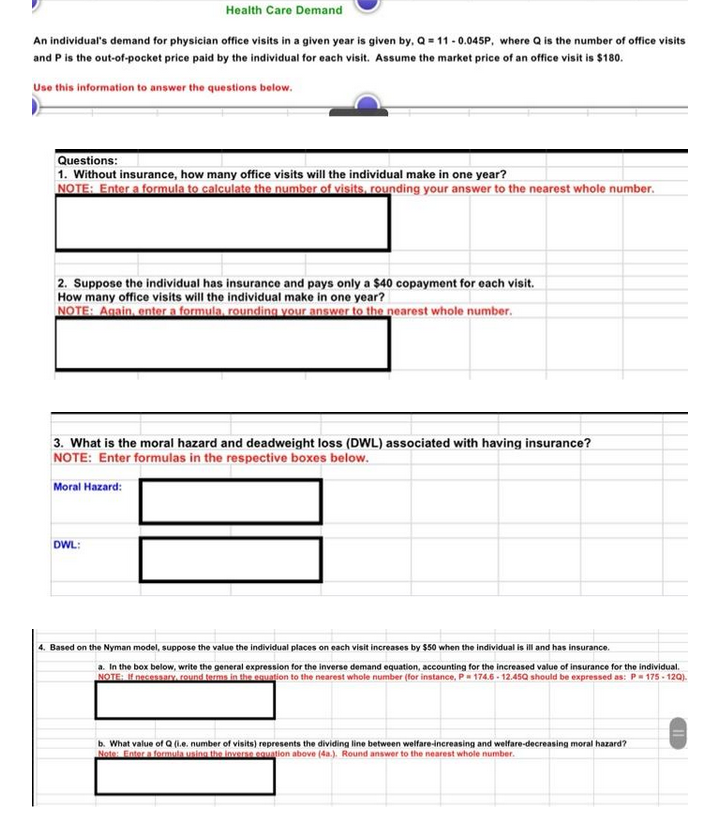An individual's demand for physician office visits in a given year is given by, Q=11-0.045P, where Q is th and P is the out-of-pocket price paid by the individual for each visit. Assume the market price of an office Use this information to answer the questions below. Questions: 1. Without insurance, how many office visits will the individual make in one year? NOTE: Enter a formula to calculate the number of visits, rounding your answer to the neares
An individual's demand for physician office visits in a given year is given by, Q=11-0.045P, where Q is th and P is the out-of-pocket price paid by the individual for each visit. Assume the market price of an office Use this information to answer the questions below. Questions: 1. Without insurance, how many office visits will the individual make in one year? NOTE: Enter a formula to calculate the number of visits, rounding your answer to the neares
Chapter6: Population Health
Section: Chapter Questions
Problem 9QAP
Related questions
Question

Transcribed Image Text:Health Care Demand
An individual's demand for physician office visits in a given year is given by, Q = 11-0.045P, where Q is the number of office visits
and P is the out-of-pocket price paid by the individual for each visit. Assume the market price of an office visit is $180.
Use this information to answer the questions below.
Questions:
1. Without insurance, how many office visits will the individual make in one year?
NOTE: Enter a formula to calculate the number of visits, rounding your answer to the nearest whole number.
2. Suppose the individual has insurance and pays only a $40 copayment for each visit.
How many office visits will the individual make in one year?
NOTE: Again, enter a formula, rounding your answer to the nearest whole number.
3. What is the moral hazard and deadweight loss (DWL) associated with having insurance?
NOTE: Enter formulas in the respective boxes below.
Moral Hazard:
DWL:
4. Based on the Nyman model, suppose the value the individual places on each visit increases by $50 when the individual is ill and has insurance.
a. In the box below, write the general expression for the inverse demand equation, accounting for the increased value of insurance for the individual.
NOTE: If necessary, round terms in the equation to the nearest whole number (for instance, P= 174.6-12.45Q should be expressed as: P=175-120).
b. What value of Q (i.e. number of visits) represents the dividing line between welfare-increasing and welfare-decreasing moral hazard?
Note: Enter a formula using the inverse equation above (4a.). Round answer to the nearest whole number.
Expert Solution
This question has been solved!
Explore an expertly crafted, step-by-step solution for a thorough understanding of key concepts.
This is a popular solution!
Trending now
This is a popular solution!
Step by step
Solved in 3 steps

Knowledge Booster
Learn more about
Need a deep-dive on the concept behind this application? Look no further. Learn more about this topic, economics and related others by exploring similar questions and additional content below.Recommended textbooks for you


Economics: Private and Public Choice (MindTap Cou…
Economics
ISBN:
9781305506725
Author:
James D. Gwartney, Richard L. Stroup, Russell S. Sobel, David A. Macpherson
Publisher:
Cengage Learning

Microeconomics: Private and Public Choice (MindTa…
Economics
ISBN:
9781305506893
Author:
James D. Gwartney, Richard L. Stroup, Russell S. Sobel, David A. Macpherson
Publisher:
Cengage Learning


Economics: Private and Public Choice (MindTap Cou…
Economics
ISBN:
9781305506725
Author:
James D. Gwartney, Richard L. Stroup, Russell S. Sobel, David A. Macpherson
Publisher:
Cengage Learning

Microeconomics: Private and Public Choice (MindTa…
Economics
ISBN:
9781305506893
Author:
James D. Gwartney, Richard L. Stroup, Russell S. Sobel, David A. Macpherson
Publisher:
Cengage Learning

Economics (MindTap Course List)
Economics
ISBN:
9781337617383
Author:
Roger A. Arnold
Publisher:
Cengage Learning

